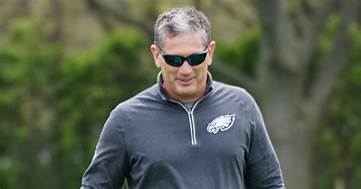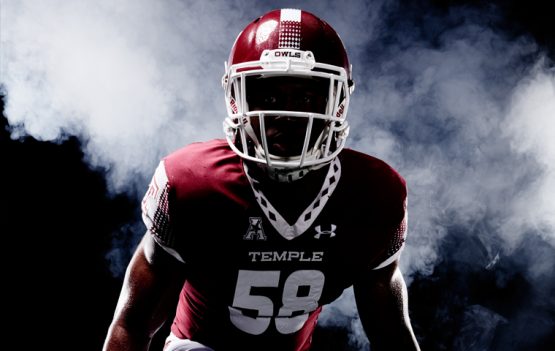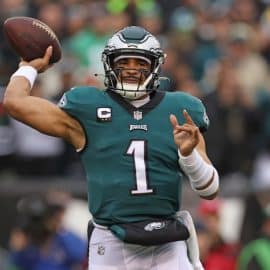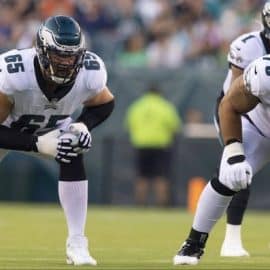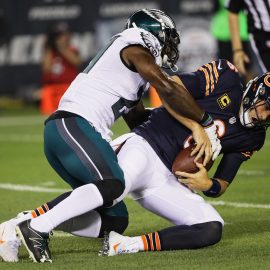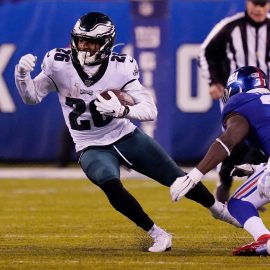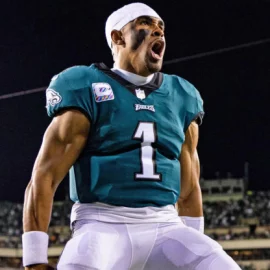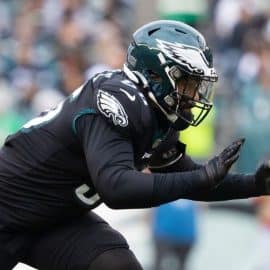Eagles defensive coordinator Jim Schwartz wasn’t the first football guy to shift around defensive positions to thwart offensive game plan tendencies. Moving safeties to linebacker and corners to safety and DE’s to linebacker in-game goes as far back in Eagles tradition as Buddy Ryan. But Schwartz is the most recent coordinator in memory to make it all work in a routine kind of way.
I’m still in a little bit of shock that Schwartz hasn’t been approached by more teams to leave the Eagles and take over their respective defenses, let alone become a head coach again.
Maybe it has something to do with that Super Bowl game in which Tom Brady threw for over 500 yards. But truth be told, the zebras did not call offensive line holding on either side in that game…perhaps a sign of things to come as the NFL gambles its high-ratings future on more offense, offense, and offense?
Anyway, the concept of defensive “shifting” based on spray charts of offensive tendencies really began with baseball back in the 1940’s. The guy it was originally meant to slow down was none other than the great Ted Williams, notorious pull hitter but also twice decorated Air Force jet pilot of WWII and Korea.
But now, defensive shifting in MLB has become as normal as you and I brushing our teef in the morning after a wild night of carousing with JB’s ex-girlfriend the Japaniard.
Richard Dyer writes a nice post at “The Sports Daily” predicting to us all that the concept of “personnel shifting” on defense is effective, whether in football or baseball, and it’s not going away.
And why don’t NFL football teams do more to make Schwartz pay when he shifts?
Try to stay with me as I make a baseball analogy (sorry)….
When faced with defensive shifts, why don’t MLB hitters slap a hit, or bunt, the other way? If they would just do that every time, those annoying shifts would disappear.
The incessant and mindless caterwauling about defensive shifting has now become white noise in the media. And throughout the general baseball community.
Here are the three reasons why Major League hitters will not attempt to “defeat” shifting, except in rare instances.
1. It is amusing to hear information-challenged writers and fans demanding that defensive shifts in the infield should be banned by Major League Baseball. (I guess they’re OK with outfielders defensively shifting to the left and right, and in and out).
But what’s really bizarre is that anyone who follows the game is still asking this question: do shifts really work?
In 2015 17,744 shifts saved 267 runs, or 66.45 shifts per run saved. And in 2016 28,074 defensive shifts saved 359 runs—78.20 S/R.
The idea that someone would believe that thousands of defensive shifts are increasingly being used by billion-dollar baseball franchises without any data to quantify the results is, frankly, stunning.
But it’s a reminder of how often fly-by commentators and casual idiots believe their own unsubstantiated “analysis”.
In fact, defensive shifts prevent run scoring. Which is, by the way, one of the two prime goals in playing Major League Baseball. (The other being run production.)
Without defensive shifts the ongoing revolution in batting launch angles, the main cause of the modern surge in home runs, would impact the game even more profoundly than it has in the past several years.
2. Here’s the other defensive shifts-related question that needs to immediately disappear: Why don’t MLB hitters just bunt or hit against the shift to beat it? And then, you know, all that shifting will go away.
The whole idea behind defensive shifts is that teams now have years of data that track every hitter’s at-bat each season. How individual batters hit righties, lefties, specific pitchers, with runners on base, and so on. So teams should ignore that valuable data and not use it to their advantage?
Also, understand that this is a universe of players who have tirelessly worked since little league to hone their individual power hitting skills (skills that are now earning them tens of millions of dollars a year).
To think that they would casually abandon their power stroke to “go the other way” to beat a defensive shift is delusional.
Getting to the big leagues is an extraordinary athletic achievement. Staying in the big leagues is a monumental athletic achievement. Bunting and slap-hitting is (correctly) not high on any hitter’s resume.
Pull hitters like the Rangers’ Joey Gallo, San Francisco first baseman Brandon Belt, and Gregory Polanco of the Pirates are not going to abandon what got them to the bigs, and has made them multi-millionaires, just because of defensive shifting.
And guess what? If a defensive shift makes a talented hitter (and at the Major League level they’re all talented) try to bunt instead of hit a home run or double, one way or another the opposing team has successfully diminished their offensive talents.
3. Finally, a player who routinely abandons his power stroke to beat defensive shifting is also in for a big surprise at contract time.
Management will happily point out any decrease in a player’s slugging percentage, which could potentially cost that player money.
Why? Because hitters are paid tremendously more for getting extra base hits and driving in runs, rather than bunting or slapping a single the other way because of a defensive shift.
So what is the actual future of MLB defensive shifting? Look at the 2017 season, and the start of the 2018 season.
The new wave of creative defensive positioning is to apply an “adaptive defense” in both the outfield and infield for every individual batter.
When Joey Gallo of the Texas Rangers stepped to the plate for his first at-bat in 2018, he faced a Houston Astros defense that featured a four-man outfield and three infielders on the right side of the diamond.
The slugging, lefty pull-hitting Gallo went 0-4 with a walk in a game Houston won 4-1.
* * * * * * * * * * * * * *
It saddens me that we lost a few of the old guardsmen along the way to the Eagles’ first official Super Bowl Championship run. It’s a mere 150 days to opening day kickoff in 2018, but these guys will miss out on the Ring Ceremony:
DDD…heart attack, fatal, in Dallas, 1952-2017…
Somalia…liver failure, fatal, in San Francisco, 1960-2017…
Blasphemer…car accident, fatal, in Danbury, Connecticut…1994-2017…
Kenemeka…bar fight, fatal stabbing, Hibbing, Minnesota… 1970-2017…
Old Bill…old age, San Antonio, Texas, 1920-2017…
Sonbutts…brain aneurism, fatal, Sarasota, Florida…1950-2017…
J. Wood (“Woodie”)…scorpion bite, Phoenix, Arizona…1931-2017…
Genetic Freak…weightlifting accident, New Zealand, 1960-2017…
Fanny Harris…driverless Uber accident, San Diego, 1965-2017…
It’s A Young Earth…cult suicide, Ghana, 1978-2017…
Mr. Kraxx…crack overdose, fatal, Metuchen, New Jersey…1985-2017…
Freight Train…freight train crossing accident, fatal, Baltimore, 1960-2017
The good news? BRIZER is still lurking!
Add The Sports Daily to your Google News Feed!
